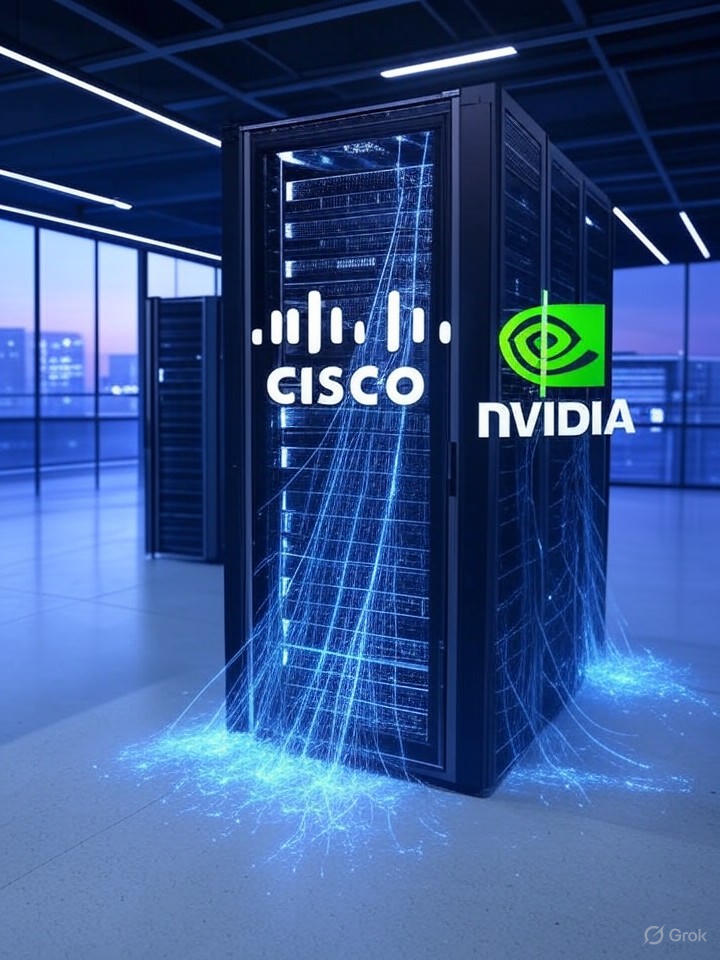The growing demand for artificial intelligence (AI) applications is transforming industries and redefining the foundation of enterprise IT. To meet this ever-increasing need for computing performance and intelligent infrastructure, Cisco and Nvidia have announced a strategic partnership aimed at reimagining the data center for the AI era. Through shared design blueprints, powerful hardware innovations, and a unified vision for the intelligent enterprise, these two tech leaders are creating the next generation of AI-ready infrastructure.
Building the AI-Driven Data Center
Modern enterprises are under intense pressure to support AI-powered workloads—from machine learning projects to natural language processing and computer vision. Traditional data centers were not built for such intensity or scale. Cisco, known for its leadership in data networking and hybrid cloud architecture, and Nvidia, the trailblazer in AI computing and GPUs, are collaborating to build infrastructure that meets this modern challenge.
At the heart of this collaboration lies the development of an ecosystem that delivers energy efficiency, computing scalability, and interoperability between networking and AI workloads. By combining Cisco’s networking intelligence and Nvidia’s GPU-accelerated computing, businesses can deploy AI models faster, securely, and more efficiently across hybrid cloud environments.
Integrated Solutions for Modern Enterprises
The partnership introduces integrated solutions designed specifically for AI workloads. These solutions combine Nvidia GPUs and Cisco UCS (Unified Computing System) servers, optimized for performance, automation, and operational efficiency. Together, they provide a foundation that supports both training and inference phases of AI workflows.
Through shared blueprints and unified management tools, enterprises can accelerate their AI adoption with fewer complications. This approach enables rapid deployment and seamless scalability for data-intensive processes, ensuring businesses remain competitive in an increasingly AI-centric economy.
Key Benefits of the Cisco and Nvidia Collaboration
- Optimized Computing Performance: Nvidia GPUs integrated into Cisco server architectures deliver unprecedented processing power, essential for deep learning and large-scale model training.
- Enhanced Network Efficiency: Cisco’s high-performance networking reduces latency and improves data throughput between GPUs and storage systems.
- Energy-Aware Infrastructure: With sustainability becoming a priority, both companies emphasize energy-efficient hardware that lowers the total cost of ownership.
- Operational Simplicity: Unified management tools streamline the deployment and maintenance of complex AI environments.
- Hybrid Cloud Readiness: The architectures are built to perform seamlessly across on-premises, private, and public cloud infrastructures.
The Importance of AI-Optimized Data Centers
The exponential growth of AI workloads is reshaping the demands placed on data centers. As organizations deploy large-scale machine learning models, the underlying infrastructure must evolve to handle higher data volumes, greater parallel processing, and increased energy consumption. AI-optimized data centers are now becoming essential in industries such as finance, healthcare, manufacturing, and automotive.
By aligning data center architecture with AI workloads, Cisco and Nvidia aim to create systems that minimize bottlenecks, maximize computational output, and enhance reliability. These enhancements make it easier for IT teams to manage performance-intensive tasks without compromising security or uptime.
Scalability and Flexibility
Scalability remains a central theme of this partnership. NVIDIA’s scalable GPU architectures, combined with Cisco’s fabric-based networking, allow organizations to add capacity as workloads increase. This flexibility supports evolving AI applications—from predictive analytics to autonomous systems—ensuring that infrastructure investments remain relevant for years to come.
Automation and AI Lifecycle Management
Another strength of this collaboration is its focus on automation. Through AI management platforms, organizations gain visibility and control over data pipelines, resources, and performance metrics in real time. Cisco’s Intersight software integrates with Nvidia’s AI Enterprise tools, providing robust lifecycle management for AI workloads—from model development to deployment.
Transforming Industries Through AI Infrastructure
The joint Cisco–Nvidia initiative goes beyond infrastructure. It aims to empower industries to innovate faster with reliable and scalable AI platforms. Sectors such as healthcare can use these systems to improve diagnostics and medical imaging. Financial institutions can harness them for smarter risk management, while manufacturers can apply them to predictive maintenance and process automation.
By accelerating innovation, the collaboration underscores how integrated technology ecosystems catalyze digital transformation. The resulting architectures serve as blueprints for AI success—combining networking excellence with computational power.
Security and Governance in AI Data Centers
Security remains at the forefront of data center strategy. AI workloads process sensitive data, making it critical to maintain robust protection for both hardware and software components. Cisco’s long-standing expertise in network security complements Nvidia’s secure GPU virtualization and AI framework protections. Together, they deliver trusted infrastructure that meets rigorous compliance and governance standards across industries.
These AI-ready data centers not only protect digital assets but also offer advanced monitoring, anomaly detection, and proactive threat mitigation to ensure AI systems operate within secure parameters.
Future Outlook: The Next Phase of AI Infrastructure
As AI continues to advance, so too must the technologies that support it. Looking ahead, this collaboration may extend beyond the data center to edge computing and cloud-native environments. Future innovations could include enhanced data orchestration, AI-driven analytics for IT operations, and the integration of quantum-ready computing models.
Moreover, Cisco and Nvidia’s blueprint for AI infrastructure serves as a model for other organizations looking to integrate AI more effectively within their digital ecosystems. The partnership demonstrates that successful AI deployment requires a fusion of powerful computing, smart networking, and simplified management.
Conclusion
The collaboration between Cisco and Nvidia marks a pivotal milestone in the evolution of data center technology. By combining their expertise, these companies are redefining how enterprises build and manage high-performance infrastructures for artificial intelligence. Their vision emphasizes scalability, energy efficiency, and innovation—core attributes of the AI-driven future. As AI adoption accelerates, Cisco and Nvidia’s partnership stands as a blueprint for how technological ecosystems can align to drive intelligence, agility, and transformation across industries.
In essence, the AI data center is no longer just a hardware hub; it is the backbone of innovation—empowering organizations to harness the full potential of artificial intelligence in an increasingly data-centric world.

